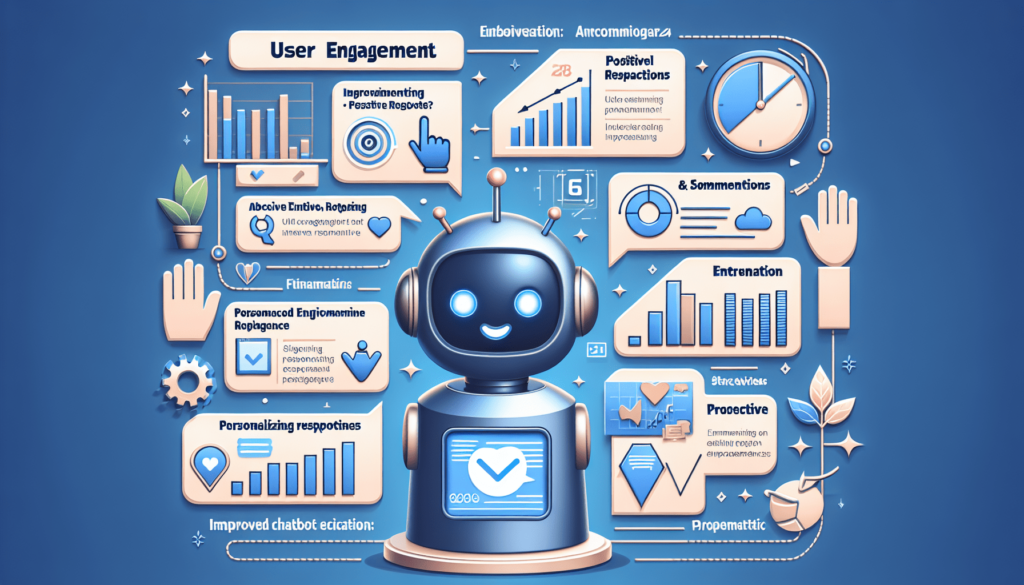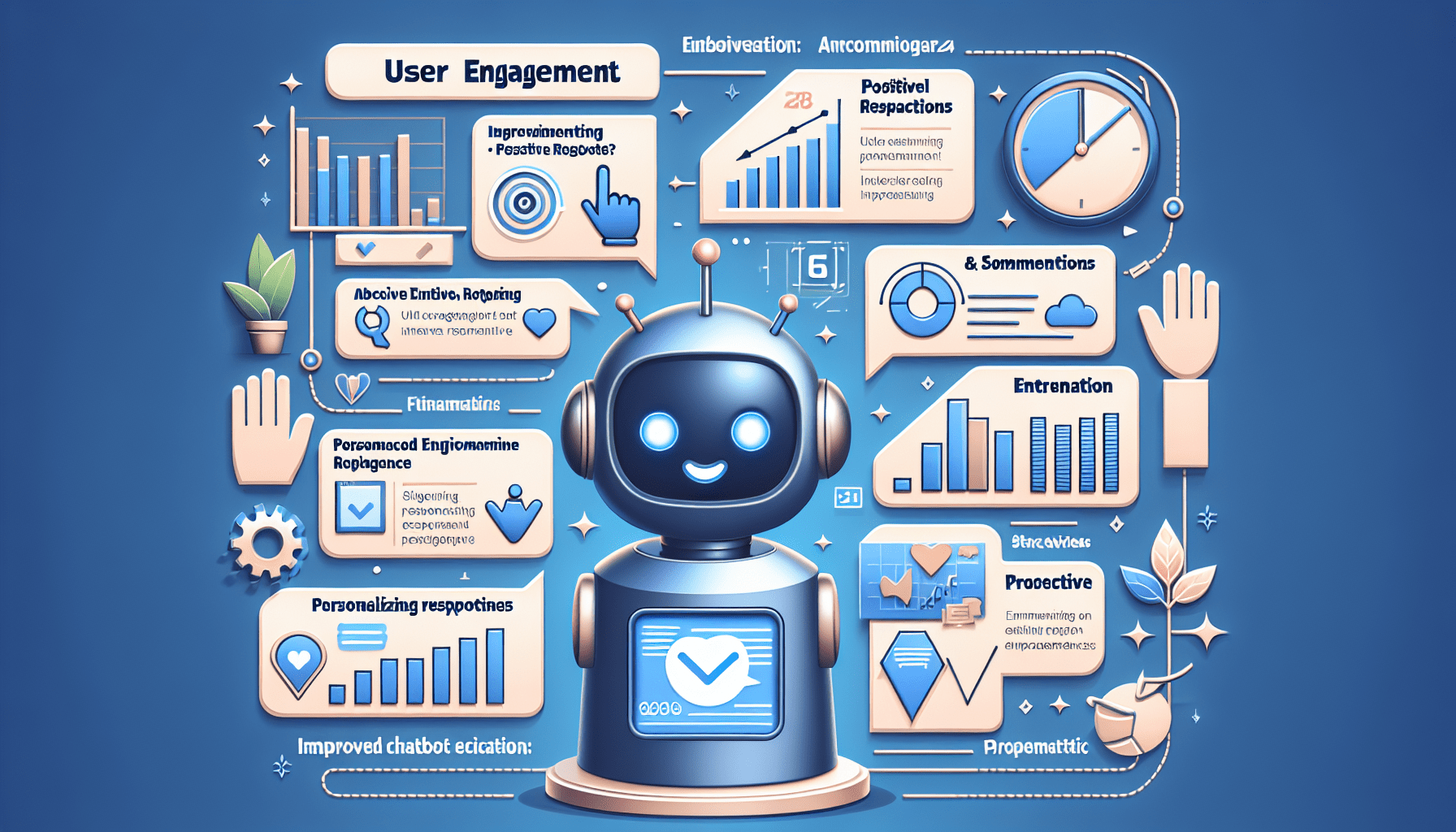Have you ever wondered how chatbots can effectively engage with users? In this article, we will explore the concept of chatbot user engagement and discuss strategies that can help chatbots create meaningful and interactive conversations. From personalized recommendations to proactive interactions, find out how chatbots can enhance user engagement and provide an enjoyable user experience. So, let’s dive in and discover the secrets of successful chatbot user engagement!

Importance of Chatbot User Engagement
Creating engaging experiences for users is essential for the success of chatbots. By focusing on user engagement, chatbots can greatly impact businesses in several ways.
Increased user satisfaction
An engaged user is a satisfied user. When chatbots are designed to actively engage with users, the overall experience becomes more enjoyable and fulfilling. Through interactive conversations, personalized recommendations, and prompt assistance, chatbots can cater to the specific needs of users and ensure their satisfaction.
Improved customer retention
Strong user engagement leads to increased loyalty and customer retention. When users feel heard, understood, and valued by chatbots, they are more likely to stick around and continue using the service or product. Chatbots can effectively build trust and loyalty by consistently delivering meaningful interactions and providing quick solutions.
Enhanced brand loyalty
Chatbots can play a significant role in building brand loyalty. By providing exceptional user experiences, chatbots create a positive image of the brand in the minds of users. Engaging chatbot interactions can leave a lasting impression, leading to increased loyalty and advocacy for the brand. When users feel connected to a chatbot, they are more likely to become loyal customers and ambassadors for the brand.
Understanding User Needs
To engage users effectively, it is important for chatbot developers to understand their needs, preferences, and pain points. This can be achieved through various methods of gathering and analyzing user data.
Collect user feedback
From surveys to live chats, collecting user feedback is crucial in understanding their needs and expectations. Chatbots can incorporate user feedback mechanisms to gather insights on user satisfaction, identify areas for improvement, and uncover new opportunities to enhance the user experience. By actively listening to users, chatbots can continuously evolve and cater to their specific requirements.
Analyze user data
Data analysis plays a vital role in understanding user behavior and preferences. By analyzing data from chatbot interactions and user profiles, businesses can gain valuable insights into user preferences, frequently asked questions, and patterns of engagement. These insights can further inform the design and functionality of chatbots to better meet user needs.
Identify pain points
By closely monitoring chatbot interactions, businesses can identify common pain points experienced by users. Whether it is a specific issue with the chatbot’s responses or a misunderstanding of user intent, recognizing and addressing these pain points is essential for improving user engagement. Through continuous refinement and updates, chatbots can constantly adapt to user needs and deliver a seamless experience.
Creating a Positive User Experience
To ensure optimal user engagement, chatbots should focus on creating a positive user experience. This involves implementing various strategies and features to enhance user satisfaction and interaction.
Implement natural language processing
Natural language processing (NLP) enables chatbots to understand and respond to user queries more effectively. By processing and interpreting the natural language input from users, chatbots can provide more accurate and relevant responses. NLP algorithms can analyze the intent behind user messages, enhancing the overall chatbot experience and promoting greater engagement.
Improve response time
Prompt responses are crucial for user engagement. Slow response times can frustrate users and discourage further interactions. By optimizing chatbot performance and minimizing delays, businesses can ensure a smooth and efficient user experience. Quick and accurate responses help to build user confidence and keep them engaged in the conversation.
Personalize interactions
Personalization adds a human touch to chatbot interactions, making users feel valued and understood. By leveraging user data and preferences, chatbots can deliver tailored recommendations, personalized responses, and customized suggestions. Personalization creates a sense of individuality, enhancing user engagement and satisfaction.
Providing Relevant and Timely Information
Offering accurate and timely information is a key aspect of engaging users effectively. Chatbots should strive to deliver the right information at the right time to maximize user engagement.
Offer accurate and up-to-date information
Users expect reliable and trustworthy information from chatbots. Chatbots should be equipped with accurate and up-to-date knowledge bases to provide users with accurate answers. Regular updates to the chatbot’s database ensure that users receive the most relevant information, promoting engagement and building trust.
Deliver proactive suggestions
Chatbots can go beyond simply answering user queries by proactively offering relevant suggestions or recommendations. By analyzing user preferences and behavior, chatbots can anticipate user needs and provide valuable suggestions or products. Proactive suggestions not only enhance user engagement but also contribute to a more personalized experience.
Provide helpful resources
In addition to answering specific queries, chatbots can enhance engagement by providing additional resources and content. By sharing relevant articles, guides, or tutorials, chatbots can empower users with the information they need to further explore a topic. This proactive approach encourages users to engage with the chatbot beyond a simple transactional interaction.
Utilizing Multichannel Support
To engage a wider audience, chatbots should be designed to provide multichannel support. This allows users to interact with the chatbot through their preferred messaging platforms and ensures a seamless experience.
Integrate with various messaging platforms
To reach users where they are, chatbots should be integrated with popular messaging platforms such as Facebook Messenger, WhatsApp, or Slack. This enables users to access the chatbot’s services without the need for additional installations or logins. By being available on multiple platforms, chatbots can engage a larger user base and provide a consistent experience across different channels.
Offer seamless transitions between channels
Users often switch between devices or platforms during their interactions. To maintain engagement, chatbots should support seamless transitions between channels. For example, a user who starts a conversation on a website should be able to continue the conversation seamlessly on their mobile device without any loss of context. Consistency and continuity contribute to a positive user experience and encourage continued engagement.
Optimize for mobile devices
As mobile usage continues to dominate, it is crucial for chatbots to be optimized for mobile devices. Mobile-friendly interfaces that are easy to navigate and interact with can significantly enhance user engagement. Responsive design, fast loading times, and efficient use of screen space ensure a seamless and enjoyable experience for mobile users.
Effective Use of Visual Elements
Incorporating visual elements into chatbot interfaces can greatly enhance user engagement. Visual content helps to communicate information more effectively, capture user attention, and create a visually appealing experience.
Incorporate visuals within chatbot interface
Visual elements such as icons, buttons, and progress indicators can contribute to a more visually engaging chatbot interface. These elements not only enhance the aesthetic appeal but also guide users through the conversation flow. Visual cues make it easier for users to understand and navigate the chatbot interface, improving engagement and interaction.
Use images and videos for better engagement
Visual content in the form of images and videos can be used to convey information more effectively. Chatbots can leverage these media formats to share product images, tutorial videos, or visual instructions. Visual content captures user attention and increases engagement, making the conversation more engaging and enjoyable.
Design visually appealing chatbot interactions
A well-designed chatbot interface with visually appealing elements creates a positive impression on users. Aesthetically pleasing design choices, such as color schemes, typography, and layout, contribute to an engaging and immersive experience. By paying attention to visual details, chatbots can create a visually cohesive and memorable user experience.
Implementing Gamification Techniques
Gamification techniques can significantly enhance user engagement by adding an element of fun and excitement to chatbot interactions.
Introduce rewards and points system
Rewarding users for their engagement and achievements can make interactions more enjoyable and rewarding. Chatbots can implement a points system where users earn points for completing certain tasks, reaching milestones, or solving challenges. These rewards can be used to unlock exclusive content, discounts, or prizes, encouraging users to stay engaged and motivated.
Include challenges and quizzes
Challenges and quizzes can introduce an element of challenge and interactivity to chatbot interactions. By providing users with opportunities to test their knowledge or skills, chatbots can create engaging and educational experiences. Challenges and quizzes can be gamified by incorporating leaderboards, time limits, or levels, fostering a sense of competition and achievement.
Encourage friendly competition
By introducing friendly competition, chatbots can motivate users to stay engaged and interact more frequently. Chatbots can create leaderboards or rankings based on user activity or achievements, encouraging users to strive for the top positions. Friendly competition fosters a sense of community and adds an element of excitement, driving user engagement.
Regular Updates and Maintenance
To ensure consistent user engagement, chatbots require regular updates and maintenance. This involves addressing any issues, improving performance, and staying up to date with evolving user needs.
Ensure chatbot functionality is up-to-date
Technological advancements and user expectations evolve rapidly. To keep up with these changes, chatbots should receive regular updates to enhance their capabilities and address any functional issues. Regular updates ensure that the chatbot remains relevant and continues to deliver a high-quality user experience.
Monitor performance and make improvements
Monitoring the performance of chatbots is crucial for identifying bottlenecks, areas of improvement, and user satisfaction. By analyzing metrics such as response times, completion rates, and user feedback, businesses can identify areas where the chatbot can be optimized. Continuous improvement leads to better user engagement and a more satisfying user experience.
Fix bugs and address user concerns
Promptly addressing bugs and user concerns is essential for maintaining user engagement. Users expect chatbots to function seamlessly and provide accurate information. By promptly addressing any technical issues or user-reported problems, businesses can ensure a smooth and reliable chatbot experience. Regular bug fixes and quick response to user concerns contribute to user satisfaction and continued engagement.
Personalization and Contextualization
By personalizing interactions and understanding user context, chatbots can create more meaningful and engaging conversations.
Tailor responses to user preferences
Personalization is key to engaging users effectively. By leveraging user data and preferences, chatbots can deliver tailored responses that directly address the user’s needs and interests. Personalized recommendations, suggestions, and content create a sense of exclusivity and relevance, driving user engagement.
Remember user information across interactions
To create a seamless and personalized experience, chatbots should remember user information and previous interactions. By recalling past conversations, preferences, and context, chatbots can provide more relevant and personalized responses. Remembering user information fosters a sense of continuity and understanding, enhancing overall engagement.
Adapt to user context
Chatbots should be able to adapt to the user’s context and provide relevant information accordingly. By understanding the user’s current situation, location, or preferences, chatbots can deliver more contextual and targeted responses. Adaptive chatbot capabilities make conversations more dynamic and engaging, ensuring a more satisfying user experience.
Continual Improvement
Chatbot user engagement should be a continuous process of analysis, learning, and improvement. With advancements in technology and the availability of user data, chatbots can continuously evolve and enhance their user engagement strategies.
Analyze user feedback and interactions
User feedback is a valuable source of insights for improving chatbot user engagement. By analyzing user feedback, businesses can understand user preferences, pain points, and areas of improvement. Taking into account user suggestions and opinions allows chatbots to continuously refine their responses, interactions, and overall user experience.
Implement machine learning algorithms
Machine learning algorithms enable chatbots to learn from user interactions and adapt their behavior over time. By leveraging machine learning, chatbots can improve their understanding of user intent, enhance response accuracy, and offer more relevant recommendations. Continuous learning and adaptation help chatbots become smarter and more engaging.
Apply natural language understanding techniques
Natural language understanding (NLU) techniques enable chatbots to understand complex user queries and context. By applying advanced NLU algorithms, chatbots can accurately comprehend user intents, disambiguate queries, and provide meaningful responses. NLU techniques contribute to a more natural and engaging conversation, driving user satisfaction and engagement.
In conclusion, chatbot user engagement is of utmost importance for businesses looking to provide exceptional user experiences. By understanding user needs, creating positive experiences, providing relevant information, utilizing multichannel support, incorporating visual elements, implementing gamification techniques, ensuring regular updates and maintenance, personalizing interactions, and continually improving, businesses can enhance chatbot user engagement and drive long-term success. By prioritizing user satisfaction, chatbots can foster loyalty, retention, and brand advocacy, contributing to the growth and success of businesses in today’s digital landscape.



